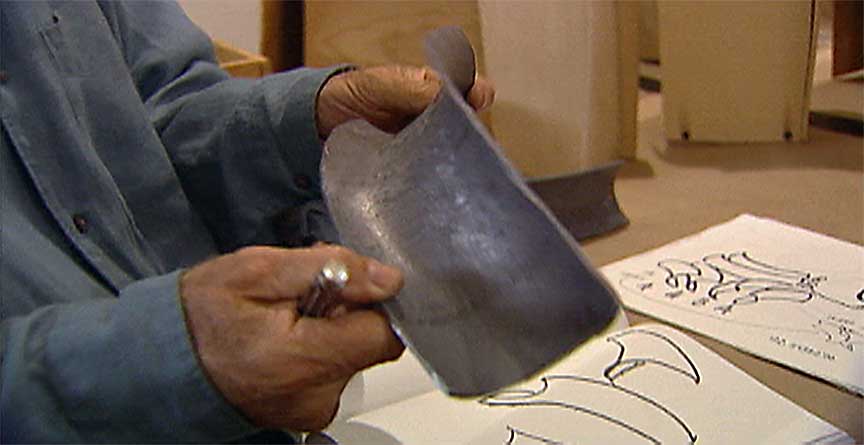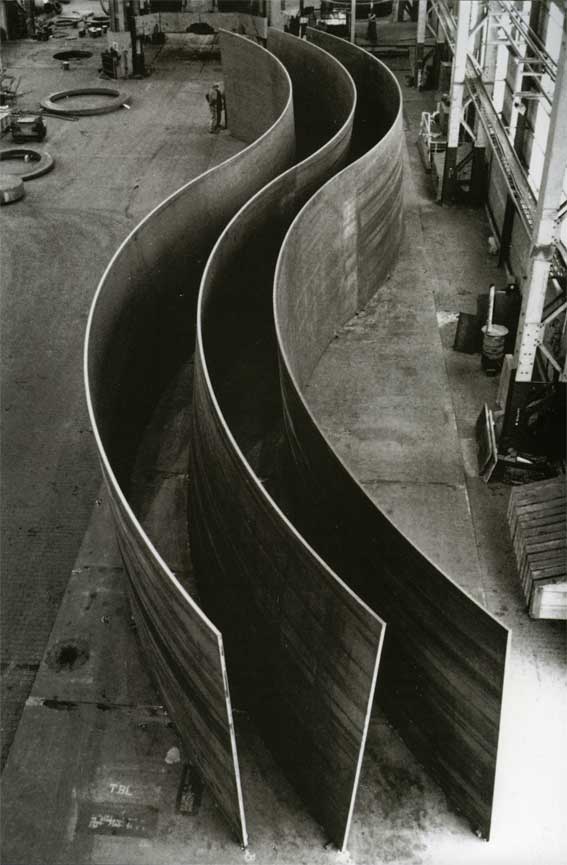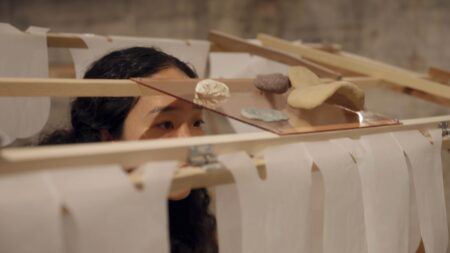Interview
Influences

Production still from the Art in the Twenty-First Century Season 1 episode, Place. © Art21, Inc. 2001.
Richard Serra talks about his relationship with the city of San Francisco, and how he uses the ocean as a metaphor in his work.
ART21: Could you tell us about being here in San Francisco—what it means to you?
SERRA: I started working for Bethlehem Steel when I was about sixteen, during the summers. And then I worked for Ryerson Steel when I was seventeen and went back to Bethlehem Steel when I was eighteen. And I worked in the steel mills in the Bay Area here, in order to pay my way through college. I think working in steel mills gave me a whole notion of how to use steel in a way that it hadn’t been used before. There was a building going up here that’s still here now, the Crown Zellerbach Building. It was one of the first riveted buildings, a high-rise built in San Francisco.
But I was around rigging of steel and the fabricating of steel in order to make money to go through school. It’s the quickest way to make the most amount of money, for the hardest amount of labor in the shortest period of time. So, there were a lot of kids who went there and worked their way through school that way. And I didn’t think I was going to come back to it until after graduate school at Yale. And then I realized that I knew about how to deal with steel, and I had a feeling for it, and I could use it in a way that it hadn’t been used in sculpture up to that point. So, I had a certain freedom to move right in to it, and use it in ways that the Industrial Revolution had used it.
The thing about coming back to the Bay Area—it’s like coming home for me. I mean, I grew up here. And you never forget about the light here; you never forget about the smell here; you never forget about these bridges. And you can travel all over the world—and I certainly don’t live here any longer, I haven’t lived here for decades—but this is truly one of the most beautiful cities I’ve ever been to.
And I think if you come from here, you have an advantage going to the East Coast because you’re not encumbered by a great deal of history. So, you don’t have the weight of Europe on your shoulders, nor the weight of the history of New York on your shoulders. You have the freedom to move from your own source or your own direction, or to discard things immediately, where you don’t feel trapped by heavy convention. If you come from the West—particularly San Francisco—it looks west, it doesn’t look east.
And mainly, when I was growing up here, the people who were the most influential were jazz musicians. Charles Mingus was here at the time. And I remember when I was about sixteen or seventeen, I went into the Jazz Workshop and had a fake ID and sat down and had a drink. And they were having a set in the afternoon. And there was a fan on; it was really loud. And Mingus was going through a set, and they were recording. And the bartender turned the fan off, and Mingus had an apoplectic fit; he just went completely crazy. He jumped over the bar, and he practically throttled the guy, and he said, “That fan was one of my instruments.”
And it made me think, as someone who wanted to be an artist, that you had to pay attention all the time to everything that was going on, because everything was potential use, if you could see its potential. I think later, John Cage made that more clear to a lot of artists. But I was very, very young at the time. And the Beat generation was starting, but I was more interested, not in the Beats, but in the Jazz Workshop here. Blacks were a big, big influence on me when I was growing up in San Francisco.

Richard Serra. One Ton Prop (House of Cards), 1969. Lead antimony, four plates; each 48 × 48 × 1 inch The Museum of Modern Art, New York. Gift of the Grinstein Family. Photo by Peter Moore. Courtesy of the artist.
ART21: Tell me about the ocean as a metaphor for you, if it is.
SERRA: I think that it’s an easy metaphor for me to use, to say that, and it’s a little simplistic. But the fact of the matter is that I’m more interested in the poetics, the vastness of the seas, say, than I am of the desert. And I’m more interested in the ocean as a way of thinking about space than I am about [urbanism]. I’m interested in the largeness of the ocean. I’m interested in the Aurora Borealis feeling of the ocean. I’m interested in the sensibility of the ocean, and I’m interested in ships. But I’m not interested in ships to make sculptures that look like ships. I mean, that’s way too simplistic. On the other hand, if there’s an underlying core of poetry that I go to, I go to the sea. I’ve lived on the sea all my life. I live on the sea in Cape Breton. I’ve never lived away from the sea, so it’s really part of what I look to, and it’s part of what nourishes me. Without sounding cornball about it, it’s something I’ve always been around.
ART21: Could you talk a little about Switch, a newer work that seems related to the Torqued Ellipses?
SERRA: Switch is strange in that, after the Torqued Ellipses, I had done pieces that were involved with conical sections. Intersections is a conical section, Ocean is a conical section, Call Me Ishmael is a conical section. And I thought that there was still something to work out in the cones in relation to the space that had evolved with the Torqued Ellipses. If you take a conical section, there are only three things you can do with it. You can either make it open, or, if you take exactly the same module, you can close it, or you can make it parallel. Parallel this way or that way. And I decided to use those three permutations in a work, and turn the inside outside.
And what happens in that piece is, when you go to the center of it, the center’s involved with all convex shapes. So, you’re walking into the center, and you’re in a triangulation of three convex plates. You’ve never found yourself, probably, confronting three convex plates, unless you’re on the outside of something. So, the inside of that piece has the feeling of being outside, and yet you’ve walked through the inside of three pathways on the outside of the inside. And then on the outside of that, there’s another outside.
So, the whole play between which way—Alice in Wonderland, Hansel and Gretel, or whatever—becomes part of that piece. And what’s interesting about that piece, for me: it has no ending and no beginning. There’s no main access. It doesn’t say “Begin here,” or “Begin there,” or “Leave here,” or “Exit there.” There are nine openings that you can go into, so it’s nondirectional in that sense. And it’s nonlinear in that sense. It’s open to any kind of discourse that you want, in terms of walking and looking and involvement. And it gives you certain feedback, psychological or otherwise, that are different in kind. And I’ve watched people actually go in there and play with the piece, in different ways. So, it gives you a different kind of charge, emphatically to your body. It gives you a different kind of empathy in relation to the sensibility of what it engenders.
Having gone back to an early series of cones and having done the ellipses, I didn’t know that the piece was going to be as complex as it ended up being. You can’t know that from a model. So, after we built the piece, I was actually surprised that the piece sustained my involvement as long as it has. Every day I’ve been back in New York while the piece was up, I’ve gone to see the piece. And it continually makes me think about other possibilities. So, that piece still holds a lot of potential for me. I don’t know how that’s going to spill out. I don’t know what kinds of works are going to come out of it, but there’s still a kind of wonder in that piece. That piece hasn’t reached closure for me. Neither has this one, Charlie Brown. But that piece particularly hasn’t. And I thought that it was probably going to be the last conical section piece I dealt with. And it’s not; I’m sure it’s not.

Richard Serra. Snake, 1996. Weatherproof steel, six curved elements; each: 13 feet 52 feet × 2 inches (13 × 104 feet overall). Installed at Dillinger Huettenwerke, Dillingen, Germany Photo by Dirk Reinartz, Buxterhude. Courtesy of Gagosian Galelry, New York.
ART21: Are you concerned at all about the viewer?
SERRA: I think that if you make enough pieces that are leaning, or if you deal with enough concave and convex sections, you understand that you have a different psychological relationship to the lean. Like, if you lean something an inch to a foot, that means at twelve feet it’s leaning a foot; or if you lean something two inches to a foot, it’s very, very different in terms of how it affects your body. What you try to do, or what I try to do, is deal with the logic of the problem without making the lean an affectation. Certainly you want an effect, but you don’t want it to make an affectation. You don’t want to get into falsely dramatizing a situation. You don’t want to throw fish to the whatever in order to get an immediate feedback. You don’t want the kind of “wow” effect.
Basically, what you really want to do is try to engage the viewer’s body relation to his thinking and walking and looking, without being overly heavy-handed about it. But you want to be able to engage the viewer nevertheless. So, if you’ve built enough pieces, you learn eventually what will give yourself release, what will give the viewer release. And you can’t think about who the other viewer is. What you have to do is think of yourself. When something’s overly claustrophobic, or when something’s overly threatening—when something allows you to walk into a passage and then feel a release—those things you learn only through the doing and only through the buildings of forms. But I don’t think of any particular viewer in mind, other than myself.



